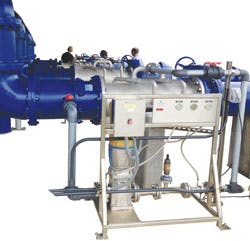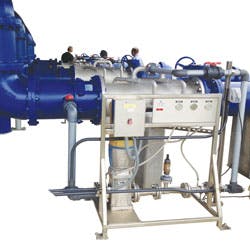Aeration System Provides Required DO Level in Pressurized Effluent Line at Mississippi WWTP
Water pollution degrades surface waters, making them unsafe for drinking, fishing, swimming, and other activities.
As authorized by the Clean Water Act (CWA), the National Pollutant Discharge Elimination System (NPDES) permit program controls water pollution by regulating point sources that discharge pollutants into waters of the United States. In most cases, the NPDES permit program is administered by authorized states. Likewise, some states establish more restrictive regulations for control of local treated effluent discharge to lakes, rivers and streams.
Many times, utilities become noncompliant with their effluent dissolved oxygen (DO) limits permit simply due to seasonal storm events, unusually high temperatures or treatment plant operational upsets. As a result, post-aeration is a critical process at all wastewater treatment plants (WWTPs).
Installation
Hancock County Utility Authority's new municipal WWTP in Southern Mississippi was designed by Carollo Engineers with a peak design flow of 6 million gallons per day (MGD). The plant has a pressurized effluent line to discharge into a local river outfall. Since the line is pressurized, a cascade, or waterfall -- the standard method for increasing DO -- was not a valid option without facing re-pumping costs.
The Solution
The engineer was looking for an easy, reliable solution, so he chose a Mazzei® Injector AirJection® aeration system for maximum transfer of oxygen with the lowest possible energy usage and minimum operator involvement. The technology is comprised of four side-stream air injection skids, each consisting of a booster pump; a 2-inch, high-efficiency Mazzei injector; a control panel; instrumentation; and a 16-inch-diameter-by-48-inch-long patented Pipeline Flash Reactor™ (PFR) for oxygenation of the secondary effluent, which runs through 1.5-MGD rated pressurized discharge pipelines designed to meet the WWTP's variable flows.
Process
For each skid, a 117-gallons-per-minute (0.16-MGD) side stream is taken off the effluent pipeline and directed through the booster pump to raise the water pressure feeding the Mazzei injector. The injector draws in ambient air and aggressively mixes it with the side-stream flow to start the dissolution process. No blowers are required for this process.
The highly-oxygenated water and entrained gas-water mixture is returned to the 316L stainless steel PFR, which utilizes Mazzei Mass Transfer Multiplier™ (MTM) Nozzles for high-shear gas-liquid mixing of the side stream for final oxygen transfer and uniform mixing. The PFRs that are used at this facility are the same PFRs that Mazzei supplies for ozonation systems used for drinking water treatment globally.
The aeration system control panel on each skid was designed to run the injection skid pump (which drives the aeration system) based on plant load levels when the WWTP effluent pumps are operating.
The Results
The plant was started up in August 2010 and has met discharge DO limits with no problems. The plant operators, who are responsible for maintaining several plants in Hancock County, appreciate the minimum maintenance and low operator involvement that this system requires. WW
Mazzei is an exhibitor at WEFTEC.14 and can be found at Booth 5637. For more information, visit www.mazzei.net.

